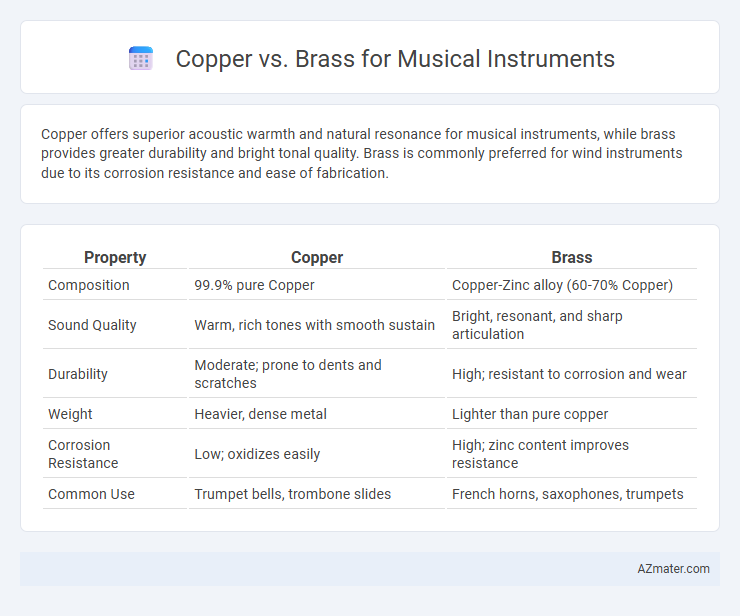Copper offers superior acoustic warmth and natural resonance for musical instruments, while brass provides greater durability and bright tonal quality. Brass is commonly preferred for wind instruments due to its corrosion resistance and ease of fabrication.
Table of Comparison
| Property | Copper | Brass |
|---|---|---|
| Composition | 99.9% pure Copper | Copper-Zinc alloy (60-70% Copper) |
| Sound Quality | Warm, rich tones with smooth sustain | Bright, resonant, and sharp articulation |
| Durability | Moderate; prone to dents and scratches | High; resistant to corrosion and wear |
| Weight | Heavier, dense metal | Lighter than pure copper |
| Corrosion Resistance | Low; oxidizes easily | High; zinc content improves resistance |
| Common Use | Trumpet bells, trombone slides | French horns, saxophones, trumpets |
Introduction to Copper and Brass in Musical Instruments
Copper and brass are essential metals in the construction of various musical instruments, each offering unique acoustic properties. Copper, known for its high thermal and electrical conductivity, is prized in instruments like cymbals and some brass instrument components for its warm, rich tonal quality. Brass, an alloy of copper and zinc, is widely utilized in instruments such as trumpets, trombones, and saxophones, providing durability and a bright, resonant sound favored in orchestras and bands.
Material Composition: Copper vs Brass
Copper, a pure metal known for its excellent electrical conductivity and malleability, serves as a fundamental material in some musical instruments, offering a warm, rich tone due to its dense atomic structure. Brass, an alloy primarily composed of copper and zinc, presents enhanced durability and machinability, making it the preferred choice for many brass instruments like trumpets and trombones, where a brighter, more resonant sound is desired. The variation in zinc content within brass alloys directly influences the instrument's timbre and corrosion resistance, providing musicians with a versatile range of tonal qualities compared to pure copper instruments.
Acoustic Properties and Sound Quality
Copper offers superior acoustic resonance with a warmer, richer tone ideal for instruments like copper drums and certain brass wind instruments. Brass, an alloy of copper and zinc, enhances durability and provides a brighter, more focused sound favored in trumpets, trombones, and saxophones. The density and alloy composition influence timbre and projection, making brass instruments more versatile in dynamic range compared to pure copper counterparts.
Durability and Longevity of Instruments
Copper exhibits excellent corrosion resistance, contributing to the durability of musical instruments such as brass horns and trumpets. Brass, an alloy of copper and zinc, offers superior hardness and strength, enhancing the longevity of instruments while maintaining acoustic quality. The combination of copper's corrosion resistance and brass's structural durability makes brass a preferred choice for long-lasting musical instruments.
Weight and Handling Differences
Copper instruments are generally heavier than brass ones due to copper's higher density, impacting portability and playing comfort during extended performances. Brass, an alloy of copper and zinc, offers a lighter weight and more balanced handling, making it preferable for musicians requiring agility and ease of movement. The weight difference influences the instrument's ergonomics and can affect player fatigue, especially in wind and brass instruments where prolonged support is necessary.
Corrosion Resistance and Maintenance
Copper exhibits excellent natural corrosion resistance due to its ability to develop a protective oxide layer that prevents further degradation, making it low-maintenance over time. Brass, an alloy of copper and zinc, offers increased strength and durability but is more prone to tarnishing and corrosion, requiring regular cleaning and polishing to maintain its appearance and performance. Choosing copper for musical instruments is ideal for those prioritizing minimal upkeep, while brass is preferred when enhanced mechanical properties outweigh the need for frequent maintenance.
Cost and Availability Comparison
Copper tends to be more expensive than brass due to its higher raw material cost and lower abundance in refined form. Brass, an alloy of copper and zinc, offers greater availability and affordability, making it a preferred choice for many musical instrument manufacturers. The cost-effectiveness and easier procurement of brass contribute to its widespread use in brass instruments like trumpets and trombones.
Preferred Applications in Instrument Types
Copper is primarily used in the winding of strings and internal components due to its excellent conductivity and flexibility, especially in brass and woodwind instruments. Brass, an alloy of copper and zinc, is favored for wind instruments like trumpets, trombones, and tubas because of its durability, workability, and bright tonal quality. The choice between copper and brass depends on the instrument type and desired sound characteristics, with brass dominating in structural parts and copper often utilized in functional elements.
Aesthetic Appeal: Color and Finish
Copper boasts a rich, warm reddish-orange hue that develops a unique patina over time, enhancing the vintage appeal of musical instruments like trumpets and saxophones. Brass offers a bright yellow-gold finish with excellent reflectivity, providing a polished and classic look favored in instruments such as trombones and tubas. Both metals allow for various surface treatments, but brass's versatility in lacquer or plating options often results in a more consistent, high-gloss aesthetic preferred by many performers.
Choosing the Right Material for Your Musical Needs
Copper offers excellent acoustic warmth and resonance, making it ideal for instruments requiring rich, mellow tones, while brass provides greater durability and a brighter, more focused sound favored in orchestral brass sections. The choice between copper and brass depends on the desired tonal quality and the instrument's function, with copper preferred for softer, expressive music and brass selected for projection and versatility. Factors such as corrosion resistance, weight, and maintenance also influence the decision to ensure the material aligns with the musician's performance needs.

Infographic: Copper vs Brass for Musical Instrument
 azmater.com
azmater.com